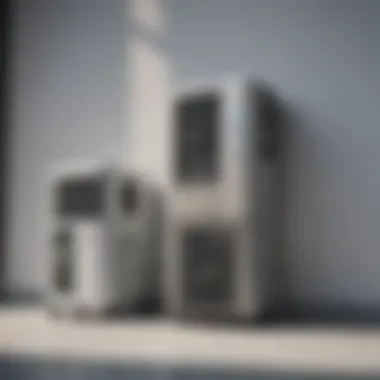Cost Considerations for Replacing Your Central Air Unit


Intro
Replacing a central air conditioning unit can feel like a daunting task for many homeowners. With various elements to consider, understanding the cost involved is paramount. The financial commitment is not limited to the unit's price alone; there are multiple layers to dissect. Knowing these layers will help you make an informed decision.
One might start by recognizing that the cost of a central air unit replacement typically includes the unit itself, installation fees, and any additional components needed. Each of these factors can vary significantly based on brand, efficiency rating, and the complexity of the installation.
When approaching this process, it is essential to grasp how energy efficiency plays a key role in costs. Higher efficiency units may come with an upfront premium but could provide substantial savings on energy bills over time.
In this article, you will uncover essential insights into budgeting for a new unit, how technological advancements affect pricing, and what to consider regarding warranties. This knowledge will not only inform your choices but may also affect the long-term value of your investment as a homeowner.
By analyzing the various components associated with replacing your central air conditioning unit, we aim to equip you with the necessary tools to navigate through the process smoothly. Let's delve deeper into the facets of cost, installation considerations, and energy efficiency of modern air conditioning systems.
Understanding Replacement Costs
Replacement costs for a central air conditioning unit can vary significantly, making it essential for homeowners to grasp the critical components and variables involved. Understanding these costs is vital not only for budgeting but also for making informed decisions regarding your home's HVAC system. Failure to consider these factors may lead to financial strain and inadequate cooling solutions during peak seasons.
Initial Cost Considerations
The initial cost for replacing a central air conditioning unit includes several factors. Homeowners should first consider the cost of the unit itself. Depending on the brand and specifications, the price can fluctuate considerably. Additionally, the location of the home plays a role in determining costs. Units in coastal areas, for example, may have different pricing due to local demand and environmental factors.
Included in the initial expenses are potential modifications needed to accommodate the new system. If the existing ductwork is outdated or incompatible, upgrades will add to the overall cost. It is prudent to also budget for any necessary permits or inspections that your local building regulations might require during installation.
Average Cost Range for Units
When it comes to the average cost of central air conditioning units, homeowners can expect prices generally ranging from $2,500 to $7,500. This range takes into account various factors such as the brand, SEER rating, and capacity of the unit. Higher SEER ratings indicate better energy efficiency but often come with a higher initial price tag. The size of the unit is also crucial; a larger home will require a system with greater capacity, which typically costs more. It's worth researching different retailers or suppliers to find competitive pricing.
An additional aspect to consider is the warranty that may come with the system. Units with extended warranty options typically feature higher purchase prices. However, they can provide peace of mind and protection against unexpected repair costs down the line.
Labor Costs Associated with Installation
Labor costs associated with the installation of a central air conditioning unit can vary based on several parameters. On average, homeowners may spend between $1,000 and $2,500 on labor alone, depending on the complexity of the installation. Several factors affect this expense, including the contractor's expertise and geographical location.
For instance, contractors in urban areas might charge a premium compared to those in more rural regions. Likewise, intricate installations involving ductwork adjustments or electrical upgrades often lead to higher labor costs. It is advisable to obtain multiple quotes from licensed contractors before making a final decision. Ensure that potential contractors present detailed assessments, including both the labor and material costs.


Factors Influencing Replacement Costs
Understanding the factors that influence replacement costs is essential for homeowners contemplating an upgrade for their central air conditioning system. These various elements can significantly affect the overall price of the project. By recognizing these factors, one can better budget and make informed decisions about the best solutions for their needs.
Unit Size and Capacity Requirements
When selecting a new central air unit, it is crucial to consider the appropriate size and capacity for the space it will serve. Installing a unit that is too small will struggle to cool the area effectively, leading to higher energy bills and reduced comfort. Conversely, an oversized unit can lead to short cycling, which affects efficiency as well. To determine the correct size, homeowners should consult the Manual J calculation. This calculation takes into account the square footage, insulation levels, and local climate. Finding a unit with the right capacity can help in optimizing energy use and ensuring maximum efficiency.
Energy Efficiency Ratings
Energy efficiency is a vital consideration when it comes to replacement costs. The efficiency of air conditioning units is measured using the Seasonal Energy Efficiency Ratio (SEER) and Energy Efficiency Ratio (EER). Higher ratings mean better energy performance, which translates into lower energy bills over time. Investing in a unit with a higher SEER rating might incur a greater initial expense, but the long-term savings on electricity can justify that upfront cost. Moreover, certain energy-efficient units might qualify for tax credits or rebates, which can offset the cost farther down the line.
Geographical Location and Climate Considerations
The geographical location heavily influences the type of central air unit needed. Areas with extreme temperatures will require more robust systems capable of handling harsher conditions. Humidity levels also play a role; units designed for dry climates might not work effectively in humid environments. This leads to added costs if improper units are initially selected. Homeowners should consider local climate when evaluating potential units to avoid unnecessary expenses and inefficiencies.
Existing Ductwork and System Compatibility
Another significant factor involves the existing ductwork and how compatible it is with the new unit. In some cases, older systems may require complete duct replacement or modification to accommodate a new air conditioning unit. If the current duct configuration does not match the new system's specifications, this can lead to heightened labor costs. Homeowners should assess their current ductwork's condition, sizing, and layout before proceeding with an upgrade. In some exceptional cases, homeowners might find that investing in a ductless mini-split system is more cost-effective, especially in homes without existing ducts.
Types of Central Air Units
Understanding the types of central air units available is essential when planning for a replacement. Each unit type has distinct features, advantages, and drawbacks that may impact your decision. The ultimate choice largely depends on your requirements, budget, and preferences. The options explored here are traditional central air conditioning systems, heat pumps, and ductless mini-split systems. Each of these types presents unique considerations in terms of energy efficiency, installation complexity, and overall performance.
Traditional Central Air Conditioning Systems
Traditional central air conditioning systems have been a popular choice among homeowners. These systems utilize ducts to distribute cool air throughout a home. One significant advantage of this type is the ability to maintain a consistent temperature across various rooms. However, there are some drawbacks. The presence of ductwork means that homes not originally built with air conditioning may require extensive renovations.
Installation costs for traditional systems can vary, influenced by the size of the unit and the home's layout. Furthermore, these systems generally need regular maintenance to ensure efficient operation. Air filters should be replaced every few months. In older units, there can be a consistent loss of efficiency.
Heat Pumps as an Alternative
Heat pumps are gaining popularity as an alternative to traditional air conditioning units. These systems can both cool and heat a home, making them versatile. They work by transferring heat rather than generating it, which often leads to higher energy efficiency compared to conventional systems. In areas with moderate climates, heat pumps can offer considerable energy savings.
That said, their efficiency can diminish in extremely cold conditions. If you live in such a climate, supplemental heating may be necessary. The installation cost for heat pumps can be comparable to central air systems, but they tend to require less maintenance over time. Regular checks on filters and system components remain critical for optimal performance.


Ductless Mini-Split Systems
Ductless mini-split systems are another worthwhile mention in the realm of central air units. They function without the ductwork associated with traditional systems. This lack of ducts simplifies installation, making them suitable for both existing homes and new constructions. They consist of an outdoor condenser unit and one or more indoor air handling units.
One notable benefit is the flexibility in cooling specific zones, allowing homeowners to customize comfort levels throughout the house. Energy efficiency is often high, leading to reduced utility bills. However, installation costs may be on the higher end due to the need for multiple indoor units.
In summary, when considering the right type of central air unit for your home, carefully evaluate your cooling needs, budget constraints, and installation capabilities. Each option has its own set of pros and cons that will influence your long-term satisfaction.
Long-Term Cost Considerations
Long-term cost considerations play a crucial role in making informed decisions about replacing a central air conditioning unit. It is not just about the initial investment; understanding the ongoing expenses associated with energy usage, maintenance, and the unit's lifespan can have significant financial implications. Homeowners must consider how these long-term factors align with their financial goals and lifestyle needs.
Energy Consumption and Utility Bills
Energy consumption is one of the most significant long-term costs to factor in when replacing a central air unit. The efficiency of a new unit can directly influence utility bills. Modern units often come with higher SEER (Seasonal Energy Efficiency Ratio) ratings, indicating that they use energy more effectively. This can lead to noticeable savings over time.
Using a less efficient air conditioning unit may result in substantially higher monthly utility bills. On average, a well-sized and energy-efficient system can reduce cooling costs by 20% to 50% compared to older models. Therefore, understanding the specific energy demands can help homeowners project costs and budget accurately.
"An energy-efficient air conditioning unit not only lowers your monthly utility bills but also decreases your environmental impact."
Maintenance and Repair Expenses
Maintenance and repair expenses should not be overlooked. An air conditioning unit, like any mechanical system, requires regular upkeep to operate at optimum efficiency. Neglecting regular maintenance can result in diminished performance and costly repairs. Some common maintenance tasks include cleaning or replacing filters, inspecting ductwork, and ensuring proper refrigerant levels.
Homeowners should also consider the potential costs of repairs if the unit malfunctions. Although newer models may come with longer warranties, inevitable wear and tear can lead to unforeseen repair expenses. Setting aside a budget annually for maintenance can mitigate these costs in the long run.
Warranty and Lifespan of Units
Finally, the warranty and expected lifespan of the air conditioning unit can significantly affect long-term costs. The warranty terms often cover parts and potentially labor for a specified period. Often, manufacturers offer warranties ranging from 5 to 10 years, with some premium models providing even longer coverage.
When assessing the overall longevity of the unit, consider that many central air systems can last between 15 to 20 years with proper care. Investing in a model with a robust warranty can provide peace of mind and financial protection against unexpected failures. Moreover, understanding the warranty details can assist homeowners in distinguishing between units that will sustain long-term use and those that may not deliver adequate value over time.
In summary, evaluating long-term costs is paramount when replacing a central air conditioning unit. Homeowners should weigh energy consumption, maintenance requirements, warranty options, and unit lifespan to make an informed choice that aligns with their financial and environmental goals.


Planning for Replacement
Planning for the replacement of your central air unit is a critical step in ensuring that your home stays comfortable and efficient. It is not merely a matter of convenience, but rather a survey of vital factors to maintain energy efficiency, reduce costs, and enhance overall home value. An informed approach can save money in the long run and can also prevent unexpected inconveniences.
Assessing When to Replace Your Unit
Understanding the right time to replace your air conditioning unit entails several considerations. If your unit is more than 10-15 years old, it may be more prone to failures and may no longer operate efficiently. Look for signs of inefficiency like inconsistent temperatures, frequent repairs, or rising utility bills. These indicators often herald the need for a new system.
A mechanic can perform an assessment of the unit to determine its functionality. If repairs exceed 50 percent of the replacement cost, it may be wise to opt for a new unit. Additionally, consider your local climate and usage patterns. Extreme weather conditions or constant air conditioning use may reduce your unit's lifespan.
Budgeting for Replacement
Budgeting for replacement involves understanding multiple cost components. First, establish a clear estimate of the initial purchase price of the new air conditioning unit. Prices vary greatly, influenced not only by the unit type but also brand and features. On top of this, add installation costs, which typically account for a significant portion of the overall expense.
Do not forget ongoing costs such as energy bills, maintenance, and potential repair fees. Creating a realistic budget can also include a small reserve for unforeseen expenses. This helps you plan efficiently around a fixed financial goal. Consider checking energy efficiency ratings, as models that save on energy may pay off within a few years.
Choosing a Qualified Contractor
Selecting a qualified contractor is essential for a successful installation. A reputable contractor will have the proper licenses and insurance, which protect you during the installation process. They should also have experience with the specific type of unit you intend to install.
When evaluating contractors, ask for references and read reviews to gauge past performance. Quality workmanship can significantly impact the longevity and performance of your new air conditioning system. A good contractor can also assist in selecting the right unit for your needs and help you navigate available local rebates.
"Proper planning is key in reducing costs and ensuring efficiency during replacement."
Culmination
The conclusion serves as an essential part of this article, summarizing key insights regarding the costs and considerations of replacing a central air conditioning unit. This section emphasizes the multifaceted nature of the replacement process, aiding homeowners in making informed decisions.
In reviewing the various aspects covered in this article, it becomes clear that understanding the cost implications, the types of units available, and the factors influencing the replacement costs is crucial. Homeowners should consider not only the initial costs but also the long-term expenses associated with energy consumption, maintenance, and possible repair needs.
Additionally, understanding when to replace an old unit and how to budget appropriately are pivotal aspects of any replacement strategy. Choosing the right contractor, with attention to detail in installation, can significantly affect the efficiency and lifespan of the chosen central air unit.
Finally, a well-planned replacement process not only enhances comfort but can lead to energy savings over time, making the investment worthwhile. Homeowners are encouraged to view the replacement as a valuable improvement rather than as an overwhelming expense.
Summarizing Key Points
- Replacement costs are influenced by several factors including unit type, size, and geographical location.
- Energy efficiency ratings can significantly impact long-term expenses.
- Existing ductwork may necessitate additional expenses or modifications during installation.
- Budget and careful assessment of contractor qualifications are essential for a successful project.
Final Thoughts on Replacement Considerations
Considering the replacement of a central air unit is a substantial endeavor. This process requires thorough research and planning. Pay attention to both immediate and future implications, as these will determine the effectiveness of the investment. Homeowners should avoid impulsive decisions driven solely by immediate needs. Instead, an informed approach will ensure long-term satisfaction and cost efficiency. By assessing technological advancements in air conditioning and the variety of products available, homeowners can optimize their choices and potentially increase their property's value while enjoying enhanced comfort.















